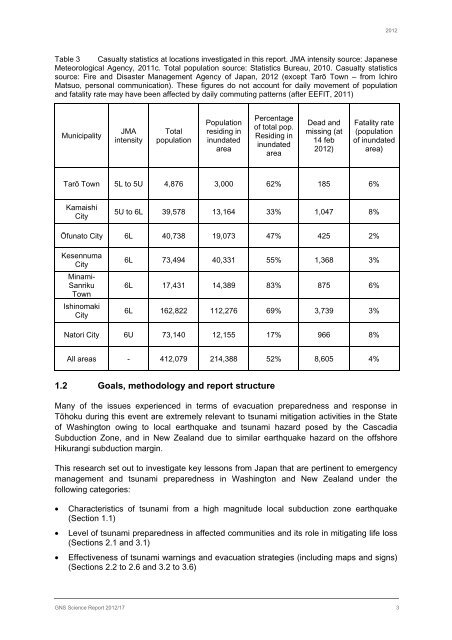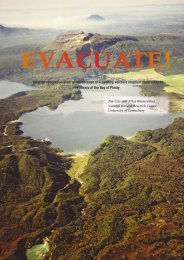Tsunami evacuation: Lessons from the Great East Japan earthquake ...
Tsunami evacuation: Lessons from the Great East Japan earthquake ...
Tsunami evacuation: Lessons from the Great East Japan earthquake ...
You also want an ePaper? Increase the reach of your titles
YUMPU automatically turns print PDFs into web optimized ePapers that Google loves.
2012<br />
Table 3 Casualty statistics at locations investigated in this report. JMA intensity source: <strong>Japan</strong>ese<br />
Meteorological Agency, 2011c. Total population source: Statistics Bureau, 2010. Casualty statistics<br />
source: Fire and Disaster Management Agency of <strong>Japan</strong>, 2012 (except Tarō Town – <strong>from</strong> Ichiro<br />
Matsuo, personal communication). These figures do not account for daily movement of population<br />
and fatality rate may have been affected by daily commuting patterns (after EEFIT, 2011)<br />
Municipality<br />
JMA<br />
intensity<br />
Total<br />
population<br />
Population<br />
residing in<br />
inundated<br />
area<br />
Percentage<br />
of total pop.<br />
Residing in<br />
inundated<br />
area<br />
Dead and<br />
missing (at<br />
14 feb<br />
2012)<br />
Fatality rate<br />
(population<br />
of inundated<br />
area)<br />
Tarō Town 5L to 5U 4,876 3,000 62% 185 6%<br />
Kamaishi<br />
City<br />
5U to 6L 39,578 13,164 33% 1,047 8%<br />
Ōfunato City 6L 40,738 19,073 47% 425 2%<br />
Kesennuma<br />
City<br />
Minami-<br />
Sanriku<br />
Town<br />
Ishinomaki<br />
City<br />
6L 73,494 40,331 55% 1,368 3%<br />
6L 17,431 14,389 83% 875 6%<br />
6L 162,822 112,276 69% 3,739 3%<br />
Natori City 6U 73,140 12,155 17% 966 8%<br />
All areas - 412,079 214,388 52% 8,605 4%<br />
1.2 Goals, methodology and report structure<br />
Many of <strong>the</strong> issues experienced in terms of <strong>evacuation</strong> preparedness and response in<br />
Tōhoku during this event are extremely relevant to tsunami mitigation activities in <strong>the</strong> State<br />
of Washington owing to local <strong>earthquake</strong> and tsunami hazard posed by <strong>the</strong> Cascadia<br />
Subduction Zone, and in New Zealand due to similar <strong>earthquake</strong> hazard on <strong>the</strong> offshore<br />
Hikurangi subduction margin.<br />
This research set out to investigate key lessons <strong>from</strong> <strong>Japan</strong> that are pertinent to emergency<br />
management and tsunami preparedness in Washington and New Zealand under <strong>the</strong><br />
following categories:<br />
• Characteristics of tsunami <strong>from</strong> a high magnitude local subduction zone <strong>earthquake</strong><br />
(Section 1.1)<br />
• Level of tsunami preparedness in affected communities and its role in mitigating life loss<br />
(Sections 2.1 and 3.1)<br />
• Effectiveness of tsunami warnings and <strong>evacuation</strong> strategies (including maps and signs)<br />
(Sections 2.2 to 2.6 and 3.2 to 3.6)<br />
GNS Science Report 2012/17 3

















